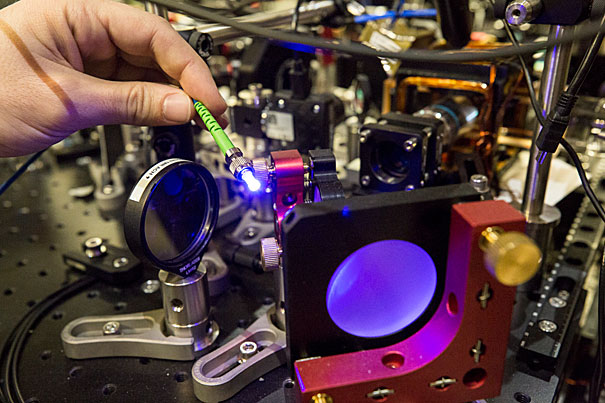Researchers create quantum calculator
New system could shed light on a host of complex processes
Programming a computer is generally a fairly arduous process, involving hours of coding, not to mention the laborious work of debugging, testing, and documenting to make sure it works properly.
But for a team of physicists from the Harvard-MIT Center for Ultracold Atoms and the California Institute of Technology, things are actually much tougher.
Working in a Harvard Physics Department lab, a team of researchers led by Harvard Professors Mikhail Lukin and Markus Greiner and Massachusetts Institute of Technology Professor Vladan Vuletic developed a special type of quantum computer, known as a quantum simulator, that is programmed by capturing super-cooled rubidium atoms with lasers and arranging them in a specific order, then allowing quantum mechanics to do the necessary calculations.
The system could be used to shed light on a host of complex quantum processes, including the connection between quantum mechanics and material properties, and it could investigate new phases of matter and solve complex real-world optimization problems. The system is described in a Nov. 30 paper published in the journal Nature.
The combination of the system’s large size and high degree of quantum coherence make it an important achievement, researchers say. With more than 50 coherent qubits, this is one of the largest quantum systems ever created with individual assembly and measurement.
In the same issue of Nature, a team from the Joint Quantum Institute at the University of Maryland described a similarly sized system of cold charged ions, also controlled with lasers. Taken together, these complimentary advances constitute a major step toward large-scale quantum machines.
“Everything happens in a small vacuum chamber where we have a very dilute vapor of atoms which are cooled close to absolute zero,” Lukin said. “When we focus about 100 laser beams through this cloud, each of them acts like a trap. The beams are so tightly focused, they can either grab one atom or zero; they can’t grab two. And that’s when the fun starts.”

Using a microscope, researchers can take images of the captured atoms in real time, and then arrange them in arbitrary patterns for input.
“We assemble them in a way that’s very controlled,” said Ahmed Omran, a postdoctoral fellow in Lukin’s lab and a co-author of the paper. “Starting with a random pattern, we decide which trap needs to go where to arrange them into desired clusters.”
More like this
As researchers begin feeding energy into the system, the atoms begin to interact with each other. Those interactions, Lukin said, give the system its quantum nature.
“We make the atoms interact, and that’s really what’s performing the computation,” Omran said. “In essence, as we excite the system with laser light, it self-organizes. It’s not that we say this atom has to be a one or a zero — we could do that easily just by throwing light on the atoms — but what we do is allow the atoms to perform the computation for us, and then we measure the results.”
Those results, Lukin and colleagues said, could shed light on complex quantum mechanical phenomena that are all but impossible to model using conventional computers.
“If you have an abstract model where a certain number of particles are interacting with each other in a certain way, the question is why don’t we just sit down at a computer and simulate it that way?” asked Ph.D. student Alexander Keesling, another co-author. “The reason is because these interactions are quantum mechanical in nature. If you try to simulate these systems on a computer, you’re restricted to very small system sizes, and the number of parameters are limited.
“If you make systems larger and larger, very quickly you will run out of memory and computing power to simulate it on a classical computer,” he added. “The way around that is to actually build the problem with particles that follow the same rules as the system you’re simulating. That’s why we call this a quantum simulator.”
Though it’s possible to use classical computers to model small quantum systems, the simulator developed by Lukin and colleagues uses 51 qubits, making it virtually impossible to replicate using conventional computing techniques.
“It is important that we can start by simulating small systems using our machine,” he said. “So we are able to show those results are correct … until we get to the larger systems, because there is no simple comparison we can make.”
“When we start off, all the atoms are in a classical state. And when we read out at the end, we obtain a string of classical bits, zeros, and ones,” said Hannes Bernien, another postdoctoral fellow in Lukin’s lab, and also a co-author. “But in order to get from the start to the end, they have to go through the complex quantum mechanical state. If you have a substantial error rate, the quantum mechanical state will collapse.”
It’s that coherent quantum state, Bernien said, that allows the system to work as a simulator, and also makes the machine a potentially valuable tool for gaining insight into complex quantum phenomena and eventually performing useful calculations. The system already allows researchers to obtain unique insights into transformations between different types of quantum phases, called quantum phase transitions. It may also help shed light on new and exotic forms of matter, Lukin said.
“Normally, when you talk about phases of matter, you talk about matter being in equilibrium,” he said. “But some very interesting new states of matter may occur far away from equilibrium … and there are many possibilities for that in the quantum domain. This is a completely new frontier.”
Already, Lukin said, the researchers have seen evidence of such states. In one of the first experiments conducted with the new system, the team discovered a coherent non-equilibrium state that remained stable for a surprisingly long time.
“Quantum computers will be used to realize and study such non-equilibrium states of matter in the coming years,” he said. “Another intriguing direction involves solving complex optimization problems. It turns out one can encode some very complicated problems by programming atom locations and interactions between them. In such systems, some proposed quantum algorithms could potentially outperform classical machines. It’s not yet clear whether they will or not, because we just can’t test them classically. But we are on the verge of entering the regime where we can test them on the fully quantum machines containing over 100 controlled qubits. Scientifically, this is really exciting.”
Other co-authors of the study were visiting scientist Sylvain Schwartz, Harvard graduate students Harry Levine and Soonwon Choi, research associate Alexander S. Zibrov, and Professor Manuel Endres.
This research was supported with funding from the National Science Foundation, the Center for Ultracold Atoms, the Army Research Office, and the Vannevar Bush Faculty Fellowship.






